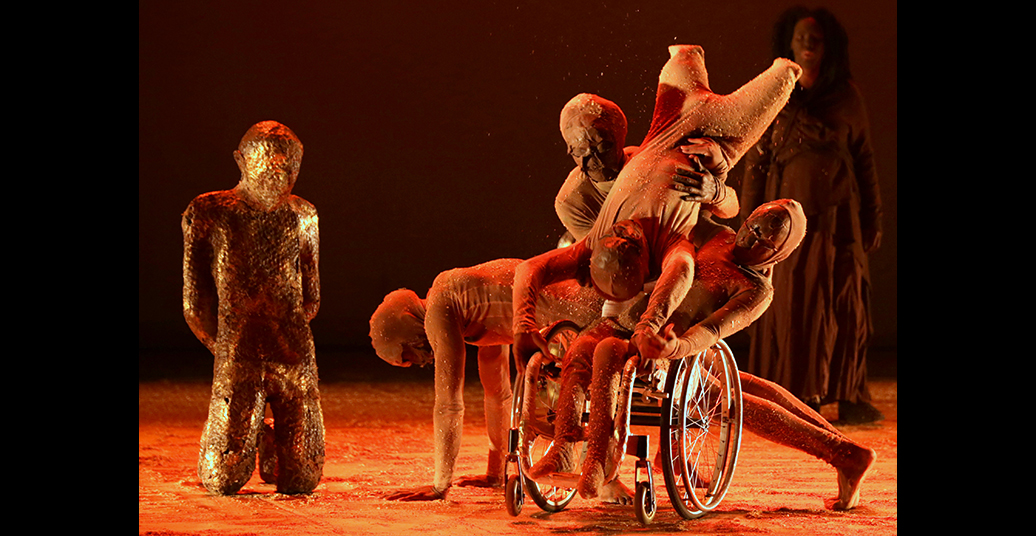As a part of the NO LIMITS Disability & Performing Arts Festival, “Ashed”, performed by Unmute Dance Company at HAU2, takes its inspiration from the petrified figures discovered in the volcanic ash of Pompeii.
Unmute Dance Company is currently the only fully inclusive dance company in South Africa. I never got the chance to see them perform back home in Cape Town, but I am familiar with Andile Vellem and Nadine Mckenzie’s past work with Remix Dance Company, before it was forced to close down due to lack of funding. The two performers have been working together for 15 years, and are pioneers in the field of integrated performance. In 2013, alongside Themba Mbuli, they co-founded Unmute Dance Company, creating a much-needed creative platform for people with mixed abilities in the performing arts.
The stage is covered in a thin layer of sawdust. Six motionless bodies are scattered around the space, as though after a battle. A few metres above the ground hang many pieces of gold-coloured rock, about the size of two fists. An explosion, suspended. A woman enters at the back of the stage, face-to-face with a figure wearing a brown bodysuit, face and head covered. Using her voice and her hands, she speaks to this figure, sending them to wake up the other, lifeless bodies. The figure approaches each of the six bodies on the stage with a concerned urgency as the woman starts to sing. After a moment of doubt, I realise that only two of these bodies are in fact living performers, also in brown bodysuits with faces hidden, while the rest are human-sized sculptures. Made by Enock Mpofu, they are impressive objects – light enough to be carried, lifted, and thrown, yet robust enough to maintain their shape and quality, and, at times, even carry the weight of the performers. Each sculpted figure has its own, unique position, and at times, it feels as though there’s a crowd on stage: a brief glimpse of a larger ensemble, the presence of those who are absent.
The three dancers (Andile Vellem, Nadine Mckenzie, and Siphenathi Mayekiso) dance with the sculptures – caressing them, praying for and to them, dragging and cradling them, always with a kind of desperation that leads them nowhere. The choreographed interactions on stage gently shift between encounters of violence and intimacy, gestures of triumph and despair. All of this action is held together by the strong and powerful voice of vocalist Babalwa Makwetu, who watches on, never fully involved but always hovering nearby.
While the aesthetic is charged with an emotive and theatrical energy, there is not so much variation in either tension or stillness. Instead, a series of scenes fluidly unfold, hitting the same tone of intensity. It feels as though I am trapped in an eternally apocalyptic moment. A part of me resonates strongly with, and finds familiarity in, this ceaseless, but almost directionless tension. After the performance during the artist talk, the choreographer Themba Mbuli draws parallels between the frozen and petrified corpses of Pompeii and the current situation in South Africa – namely, a feeling of collective paralysis and entrapment within the ever-repeating history of a society that has been very specifically designed to benefit a privileged minority. From the erasure of whole knowledge systems and cultures with the arrival of the European coloniser, to the devastating laws of apartheid, to corrupt government officials, the traumas of South Africa’s history seem to play out in endlessly oppressive ways. But this cycle of historic repetition is certainly not unique to South Africa, and with a wise, almost sophisticated sorrow, “Ashed” manages to name the conundrum of how terribly and violently designed our current global structure is.
On the way home I consider the differences between a volcanic eruption and the past 500 years of structural oppression, which many history books refer to as ‘modernity’. Both involve a lot of suffering, but where natural disasters (such asMount Vesuvius erasing Pompeii) occur, destroy, and then become history, manmade disasters (like the colonial matrix of power[1]) aren’t so simple. Instead of becoming history, they become the norm. Erasing life slowly, they are all the more dangerous because of their insidious, almost invisible nature of operating. At least you can see a volcano.
[1] See “Coloniality of Power, Eurocentrism, and Latin America” by Anibal Quijano.




